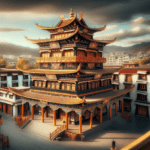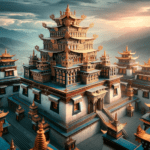Introduction to Zhaguo Temple
Sacred Origins: Zhaguo Temple, also known as “Nie Chawu Temple,” is a revered site nestled in Tunma Village, Xinba Township, Longzi County, at an altitude of 3910 meters. This temple was established by Nie Zhaguowa, a disciple of the esteemed Kadam Sect monk Podowa (1031 —1105). Initially aligned with the Kadam Sect, it later transitioned to the Gelug Sect, reflecting the dynamic spiritual history of the region.
The Temple’s Expansive Footprint
Architectural Layout: Spanning 150 meters in length from east to west and 40 meters in width from north to south, Zhaguo Temple covers an impressive area of about 6000 square meters. Its layout, stretching from east to west, offers a unique perspective of Tibetan monastic architecture.
Architectural Evolution of Zhaguo Temple
A Timeline of Structures: The temple’s architecture can be categorized into three distinct periods: early, middle, and late. Each era has contributed significantly to the temple’s current form, embodying the evolution of Tibetan Buddhist architecture over centuries.
Early Period (Qianhong Period) Constructions: During the early phase, known as the “Qianhong period,” the main structures included Qu’okang and the Lawabu monastery.
- Qu’okang: This was a small hall with rammed earth walls, occupying merely 20 square meters. It symbolized the humble beginnings of the temple, focusing on simplicity and spiritual devotion. Unfortunately, Qu’okang no longer exists today.
- Lawabu Monastery: Unique in its construction, the Lawabu Monastery was composed of two natural caves. These caves are notable as they represent the earliest remains of the temple, indicating the use of natural landscapes in early Tibetan monastic architecture.
Zhaguo Temple, with its rich history and architectural evolution, stands as a testament to the deep spiritual roots and cultural heritage of Tibetan Buddhism. From its inception under the guidance of a Kadam Sect disciple to its current affiliation with the Gelug Sect, the temple not only reflects the religious transformations of Tibet but also showcases the adaptability and resilience of Tibetan Buddhist architecture through the ages. Whether as a place of worship, a site of historical significance, or an architectural marvel, Zhaguo Temple remains a significant destination in the Tibetan spiritual landscape.
Zhaguo Temple: Architectural Evolution from the Middle to Late Periods
Middle Period Architecture (“Houhong Period”)
Westernmost Rammed Earth Wall Palace: During the middle period, known as the “Houhong period,” a notable structure was the westernmost rammed earth wall palace. This building, covering an area of about 40 square meters, now stands only as ruins. However, it represents an essential phase in the temple’s architectural history, marking a transition in building styles and techniques.
Late Period Architecture (17th to 19th Centuries)
Expansion and Diversification: In the late period, spanning the 17th to 19th centuries, the temple’s architecture saw significant expansion and diversification. This era introduced several new buildings:
- Lingpa Group: A cluster of buildings, possibly serving various religious and communal purposes.
- Jikang and Zubulakhang: These structures likely served as central halls or places of worship within the temple complex.
- Quere (Lecture Place): A dedicated area for teachings and lectures, highlighting the temple’s educational role.
- Gongkang (Dharma Protector Temple): A temple dedicated to the Dharma Protectors, an integral part of Tibetan Buddhism.
- Monks’ Residences: Living quarters for the monks, providing insights into the daily life within the temple.
Zubra Kang – The Main Building:
Zubra Kang stands as the main building in the late period architecture:
- Upper Floor: Houses a reception room and auxiliary buildings, indicating the temple’s role in hosting religious gatherings and important meetings.
- Lower Floor: Features a porch, Dukang Hall, and a Buddhist temple. The porch, with its four columns, covers about 40 square meters and is adorned with significant paintings: the Four Heavenly Kings on the east wall, the picture of reincarnation on the north wall, and the temple chronicles on the south wall.
Dukang Hall’s Architectural Splendor: The Dukang Hall, connected to the porch, is notable for its size and design:
- Dimensions: The hall is 19 meters wide and 18.4 meters deep, containing 36 square upright columns arranged in a grid pattern.
- Central Columns and Illuminated Shed: The middle four columns, each 10 meters high, support the upper floor of the straight roof, forming a patio-style illuminated shed. This area is embellished with murals of Tara, Padmasambhava, and the Three Masters and Disciples of Tsongkhapa, adding to the hall’s spiritual significance.
Buddhist Hall: The Buddhist hall, measuring 8 meters in width and 3 meters in depth, houses statues of Sakyamuni Buddha, the Third Buddha, Jampa Buddha, and others, underscoring the temple’s religious importance.
The architectural journey of Zhaguo Temple, from its middle to late periods, showcases a rich tapestry of Tibetan monastic architecture. Each structure, from the remnants of the rammed earth wall palace to the grandeur of Zubra Kang and Dukang Hall, reflects the temple’s evolving role as a spiritual, educational, and cultural hub in Tibetan Buddhism. This evolution mirrors the broader changes in Tibetan religious architecture over centuries, making Zhaguo Temple a significant site for understanding the region’s cultural and spiritual heritage.
Zhaguo Temple: A Tapestry of Murals and Cultural Insights
Highlights of Zhaguo Temple’s Artistry
① Dukang Hall Murals: A Ming Dynasty Masterpiece
The Dukang Hall within Zhaguo Temple houses an exquisite collection of murals from the Ming Dynasty, each wall telling a unique story:
- East Wall: This wall features portraits of the 1st to 10th Dalai Lamas in a north-to-south sequence, accompanied by eight Medicine Master Buddha statues. This alignment showcases the religious hierarchy and spiritual lineage revered in Tibetan Buddhism.
- West Wall: From north to south, the murals depict Tantric protector gods such as the God of Eternal Awakening, Chakrasamvara, Gyasaja Vajra, Yamantaka, and White Yihu God. The center of the wall highlights the Infinite Light Buddha, flanked by the eight bodhisattvas, symbolizing the bodhisattvas’ role in following the Buddha.
- North Wall: The biographical journey of Sakyamuni is painted from west to east. In the center, a seated statue of Sakyamuni and the sixteen Arhats is depicted, representing the core of Buddhist teachings and the lineage of saintly beings.
- South Wall: The eastern section of the wall is adorned with a sequential portrayal of the Gelug sect’s lineage of living Buddhas. The western section features statues of eminent monks and great masters, including the founding living Buddha of the temple and Padmasambhava.
Additionally, the east wall of the main hall’s porch is painted with the Four Heavenly Kings, the north wall with a picture of reincarnation, and the south wall records the temple’s history. The patio shed murals include images of Tara, Master Padmasambhava, and three statues of Tsongkhapa.
② Dharma Protector Temple Mural: Qing Dynasty Art
The Dharma Protector Temple’s murals, dating back to the Qing Dynasty, offer a different historical perspective:
- West Wall: Features a panoramic view of Sakya Monastery and three statues of Tsongkhapa and his disciples, symbolizing the temple’s connection to wider Buddhist traditions.
- North Wall: Dominated by a statue of Vairochana Buddha, with images of Dromdumba and the four-armed Guanyin Bodhisattva, emphasizing the importance of these figures in Tibetan Buddhism.
- East Wall: Centralizes on Master Tsongkhapa, surrounded by scenes from the three major temples in Lhasa, highlighting the temple’s ties to key Tibetan Buddhist landmarks.
Tour Tips for Zhaguo Temple Visitors
① Accessibility: No tickets are required for temple entry, though donations are welcomed and appreciated, allowing visitors to contribute to the temple’s maintenance and religious activities.
② Getting There: The temple is situated about 8 kilometers from the county seat. Visitors can opt for self-driving, chartering a car, or walking. Chartering a car is a convenient option, typically costing around 25 yuan.
Conclusion
The Zhaguo Temple stands as a vivid canvas of Tibetan Buddhist history and art. Its murals from different dynasties not only depict religious figures and narratives but also offer a window into the artistic styles and cultural values of the times. Whether for spiritual enrichment, historical interest, or artistic appreciation, a visit to Zhaguo Temple promises a rich and enlightening experience.




